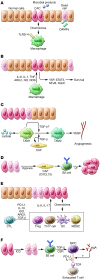Immunity, inflammation, and cancer: an eternal fight between good and evil
- PMID: 26325032
- PMCID: PMC4588298
- DOI: 10.1172/JCI80007
Immunity, inflammation, and cancer: an eternal fight between good and evil
Abstract
Cancer development and its response to therapy are strongly influenced by innate and adaptive immunity, which either promote or attenuate tumorigenesis and can have opposing effects on therapeutic outcome. Chronic inflammation promotes tumor development, progression, and metastatic dissemination, as well as treatment resistance. However, cancer development and malignant progression are also associated with accumulation of genetic alterations and loss of normal regulatory processes, which cause expression of tumor-specific antigens and tumor-associated antigens (TAAs) that can activate antitumor immune responses. Although signals that trigger acute inflammatory reactions often stimulate dendritic cell maturation and antigen presentation, chronic inflammation can be immunosuppressive. This antagonism between inflammation and immunity also affects the outcome of cancer treatment and needs to be considered when designing new therapeutic approaches.
Figures


References
-
- Wallach D, Kang TB, Kovalenko A. Concepts of tissue injury and cell death in inflammation: a historical perspective. Nat Rev Immunol. 2014;14(1):51–59. - PubMed
-
- Spencer WG. Celsus. De medicina. Loeb Classical Library. Cambridge, Massachusetts, USA: Harvard University Press; 1938.
-
- Nunn JF. Ancient Egyptian Medicine. Norman, Oklahoma, USA: University of Oklahoma Press; 2002.
Publication types
MeSH terms
Substances
Grants and funding
LinkOut - more resources
Full Text Sources
Other Literature Sources

